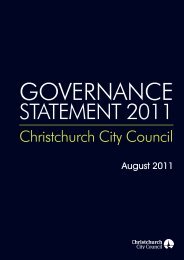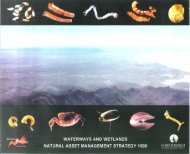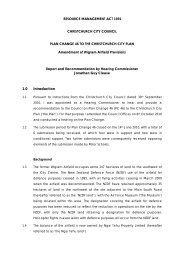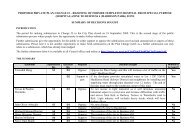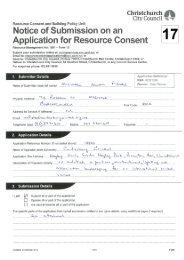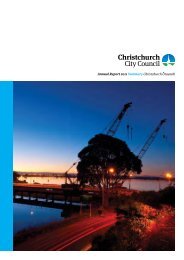Annual Report 2010 - Christchurch City Council
Annual Report 2010 - Christchurch City Council
Annual Report 2010 - Christchurch City Council
You also want an ePaper? Increase the reach of your titles
YUMPU automatically turns print PDFs into web optimized ePapers that Google loves.
p152.<br />
<strong>Annual</strong> <strong>Report</strong><br />
<strong>Christchurch</strong> Otautahi<br />
<strong>2010</strong><br />
Financial statements<br />
Statement of<br />
accounting policies<br />
(continued)<br />
Notes to financial statements<br />
1. Statement of accounting policies (continued)<br />
Revenue<br />
(i)<br />
Rates, goods sold and services rendered<br />
Revenue from rates is recognised through profit and loss<br />
at the time of invoicing. Revenue from the sale of goods is<br />
recognised through profit and loss when the significant<br />
risks and rewards of ownership have been transferred to the<br />
buyer. Revenue from services rendered is recognised through<br />
profit and loss in proportion to the stage of completion of the<br />
transaction at the balance sheet date. The stage of completion<br />
is assessed by reference to surveys of work performed. No<br />
revenue is recognised if there are significant uncertainties<br />
regarding recovery of the consideration due, associated costs<br />
or the possible return of goods or continuing management<br />
involvement with the goods.<br />
(ii) Construction contracts<br />
As soon as the outcome of a construction contract can be<br />
estimated reliably, contract revenue and expenses are<br />
recognised through profit and loss in proportion to the stage<br />
of completion of the contact. The stage of completion is<br />
assessed by reference to surveys of work performed.<br />
An expected loss on a contract is recognised immediately<br />
through profit and loss.<br />
(iii) Finance Income<br />
Finance income comprises interest receivable on funds<br />
invested and on loans advanced. Finance income, is<br />
recognised through profit and loss as it accrues, using the<br />
effective interest method.<br />
(iv) Rental income<br />
Rental income from investment and other property is<br />
recognised through profit and loss on a straight-line basis<br />
over the term of the lease. Lease incentives granted are<br />
recognised as an integral part of the total rental income.<br />
(v) Government grants<br />
Grants from the government are recognised as income at their<br />
fair value where there is a reasonable assurance that the grant<br />
will be received and the <strong>Council</strong> will comply with all attached<br />
conditions.<br />
(vi) Dividend income<br />
Dividend income is recognised when the shareholder’s right<br />
to receive payment is established.<br />
(vii) Finance lease income<br />
Finance lease income is allocated over the lease term on<br />
a systematic and rational basis. This income allocation is<br />
based on a pattern reflecting a constant periodic return on the<br />
<strong>Council</strong>’s net investment in the finance lease.<br />
(viii) Development Contributions<br />
Development contributions are recognised through profit and<br />
loss in the year in which they are received.<br />
(ix) Other gains<br />
Other gains include revaluations of investment properties<br />
(see Investment Property policy), gains from the sale of<br />
property, plant and equipment and investments and gains<br />
arising from derivative financial instruments (see hedging<br />
policy).<br />
Expenses<br />
(i) Operating lease payments<br />
Payments made under operating leases are recognised<br />
through profit and loss on a straight-line basis over the term<br />
of the lease. Lease incentives received are recognised through<br />
profit and loss as an integral part of the total lease expense.<br />
(ii) Finance lease payments<br />
Minimum lease payments are apportioned between the<br />
finance charge and the reduction of the outstanding liability.<br />
The finance charge is allocated to each period during the<br />
lease term so as to produce a constant periodic rate of interest<br />
on the remaining balance of the liability.<br />
(iii) Finance costs<br />
Finance costs comprise interest payable on borrowings<br />
calculated using the effective interest rate method. The<br />
interest expense component of finance lease payments is<br />
recognised through profit and loss using the effective interest<br />
rate method. Interest payable on borrowings is recognised as<br />
an expense through profit and loss as it accrues.<br />
(iv) Other losses<br />
Other losses include revaluation decrements relating to<br />
investment properties (see Investment Property policy),<br />
losses on the sale of property, plant and equipment and<br />
investments and losses arising from derivative financial<br />
instruments (see hedging policy).





